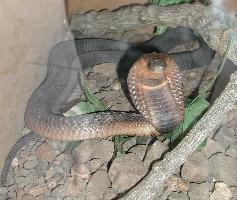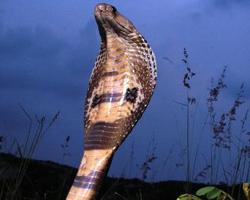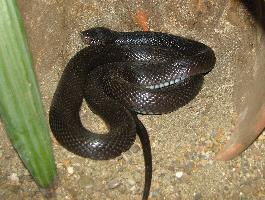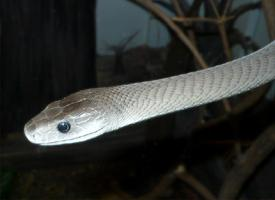
Poids et mesures
| Longueur | 3 m |
|---|
Description de l'animal
The Egyptian cobra, scientifically known as Naja haje, is a captivating and formidable species of cobra native to the deserts and savannas of North Africa through to the Middle East. This species, emblematic of mystery and power, holds a significant place in ancient Egyptian culture and mythology, often depicted in art and associated with royalty and divine authority.Characterized by its impressive length, the Egyptian cobra can grow to be one of the largest cobra species, with adults typically reaching up to 2 meters (about 6.6 feet), though some specimens have been recorded at lengths of up to 3 meters (nearly 10 feet). The snake's body is robust and cylindrical, with a distinctive hood which it expands when threatened, displaying a fascinating and intimidating spectacle. The coloration of this species varies across its range, predominantly featuring shades of brown, tan, or grey, often with darker patterning, which provides excellent camouflage against the desert and savanna landscapes it inhabits.
The head of the Egyptian cobra is large and slightly flattened, with a rounded snout. Its eyes are moderate in size, with round pupils, a characteristic feature distinguishing it from the slit pupils of vipers. The facial scales are smooth, and the coloration often matches the rest of the body, with some individuals exhibiting a darker or lighter color band around the neck area.
As a highly venomous species, the Egyptian cobra possesses a potent neurotoxic venom, which it delivers through its short, fixed fangs at the front of its mouth. This venom is capable of causing severe neurological damage, leading to symptoms such as pain, swelling, necrosis, and in severe cases, respiratory failure or death. The snake uses its venom primarily for hunting, preying on a wide variety of animals including small mammals, birds, amphibians, and even other snakes. Its diet varies depending on the availability of prey in its environment.
The Egyptian cobra is primarily nocturnal, especially in hot climates, seeking refuge from the heat during the day in burrows, under rocks, or in abandoned animal dens. It is known for its impressive swimming ability and can often be found near water sources. Despite its fearsome reputation, this cobra is generally elusive and avoids confrontation with humans whenever possible. However, when cornered or threatened, it will not hesitate to stand its ground, raising its body off the ground, spreading its iconic hood, and hissing loudly as a warning before striking if necessary.
Reproduction in Egyptian cobras involves oviparity, meaning the female lays eggs. After mating, the female will lay a clutch of 12 to 20 eggs, which she may guard or leave to incubate in the warmth of decomposing vegetation or in the sand. The eggs hatch after approximately 60 to 90 days, releasing fully independent young cobras, which are venomous from birth and capable of fending for themselves.
The Egyptian cobra's role in the ecosystem is significant, as it helps control populations of rodents and other small animals, thus maintaining the balance within its habitat. However, like many species, it faces threats from habitat destruction, persecution due to fear, and collection for the pet trade. Conservation efforts are necessary to ensure the survival of this iconic species, which continues to fascinate and inspire humanity with its majesty and mystery.
Animaux similaires
Nouvelles photos d'animaux
Top 10 des animaux
- Dolphin gull (Leucophaeus scoresbii)
- Diana monkey (Cercopithecus diana)
- Moustached guenon (Cercopithecus cephus)
- Galápagos tortoise (Geochelone nigra complex)
- Russian tortoise (Testudo horsfieldii)
- Japanese macaque (Macaca fuscata)
- Stone loach (Barbatula barbatula)
- Greek tortoise (Testudo graeca)
- Common flying dragon (Draco volans)
- Colossal squid (Mesonychoteuthis hamiltoni)


